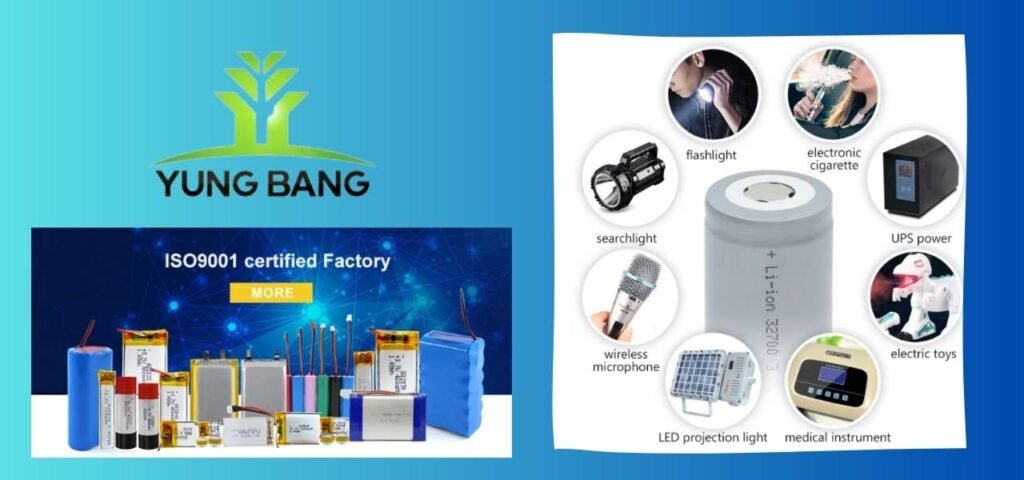Marine lithium-ion polymer (Li-Poly or LiPo) batteries are becoming increasingly popular in the boating industry due to their high energy density, lightweight design, and long lifespan compared to traditional lead-acid batteries. These batteries are particularly beneficial for powering electric boats, yachts, trolling motors, marine electronics, and off-grid applications.
In this guide, we will explore the advantages of marine LiPo batteries, how they compare to other marine battery types, their safety considerations, and best practices for choosing and maintaining them in marine environments.

What Are Marine Lithium Ion Polymer Batteries?
Marine lithium-ion polymer batteries are a specific application of Li-Poly batteries designed to meet the unique demands of marine environments. These batteries use lithium-ion chemistry with a polymer electrolyte, which allows for a more flexible and lightweight design compared to traditional marine batteries, such as flooded lead-acid or gel batteries.
Key Features of Marine LiPo Batteries:
- High energy density: Marine LiPo batteries store more energy in a smaller volume, making them ideal for space-constrained marine applications.
- Lightweight: They weigh significantly less than traditional marine batteries, which helps reduce the overall weight of the boat and improves performance.
- Longer lifespan: Marine LiPo batteries can last several times longer than lead-acid batteries, often providing 2,000 to 5,000 charge cycles with proper care.
- Fast charging: These batteries can charge faster than most traditional battery types, reducing the downtime for recharging.
- Low maintenance: Unlike lead-acid batteries, lithium-ion polymer batteries do not require regular maintenance such as checking water levels or cleaning terminals.
Advantages of Using Lithium Ion Polymer Batteries in Marine Applications
1. Lightweight and Compact
One of the most significant advantages of Li-Poly batteries in marine applications is their lightweight design. Traditional marine batteries, especially lead-acid batteries, are heavy and bulky. Li-Poly batteries are much lighter, which can improve the boat’s performance by reducing weight and increasing speed and fuel efficiency.
2. Higher Energy Density
LiPo batteries have a much higher energy density than lead-acid batteries. This means that they can store more energy in a smaller volume, allowing boat owners to either reduce the number of batteries needed or increase the available power while using the same battery space.
3. Longer Lifespan
In marine environments, durability and lifespan are critical. Li-Poly batteries can last between 2,000 and 5,000 charge cycles, depending on usage and proper maintenance. In comparison, lead-acid batteries typically last only 300 to 500 cycles. This extended lifespan makes LiPo batteries a more cost-effective solution in the long run, despite their higher initial cost.
4. Fast Charging
LiPo batteries can charge much faster than their lead-acid counterparts. In marine environments where downtime can be costly or inconvenient, the ability to recharge quickly is a significant advantage. Most LiPo batteries can be charged to 80% capacity in just a few hours, compared to the significantly longer charging times of lead-acid batteries.
5. Low Self-Discharge Rate
LiPo batteries have a low self-discharge rate, meaning they retain their charge for longer periods when not in use. This is particularly useful for seasonal boating or when boats are stored for long periods, as the batteries won’t lose as much charge during storage.
6. Maintenance-Free
Unlike lead-acid batteries, which require regular maintenance (checking electrolyte levels, cleaning terminals, etc.), LiPo batteries are maintenance-free. This is a significant advantage in marine environments, where corrosion and wear from exposure to saltwater can be problematic.
Disadvantages of Marine Lithium Ion Polymer Batteries
While LiPo batteries offer many advantages, they also have some drawbacks, especially when used in marine environments:
1. Higher Initial Cost
LiPo batteries are more expensive upfront compared to traditional lead-acid or AGM batteries. However, their longer lifespan and lower maintenance costs can offset this higher initial expense over time.
2. Sensitive to Overcharging and Over-discharging
Marine LiPo batteries are more sensitive to overcharging and over-discharging than other battery types. Overcharging can lead to swelling, overheating, or even fire, while deep discharging can permanently damage the battery. Using a battery management system (BMS) is crucial to prevent these issues.
3. Safety Concerns
While LiPo batteries are generally safe when used correctly, they can be prone to thermal runaway if damaged, overcharged, or exposed to extreme heat, which can result in overheating or fire. This makes it essential to use proper charging equipment and follow safety guidelines, especially in enclosed spaces like boat cabins.
4. Limited Cold Weather Performance
LiPo batteries are less efficient in extremely cold temperatures. In marine environments where boats may be exposed to cold weather, LiPo batteries may experience reduced capacity and performance. Some batteries come with heating systems to mitigate this issue, but it’s something to consider if boating in colder climates.
Marine Lithium Ion Polymer vs. Lead-Acid Batteries
1. Weight
- LiPo Batteries: Lightweight, typically 60-70% lighter than lead-acid batteries.
- Lead-Acid Batteries: Heavy, which can affect boat speed, fuel efficiency, and overall performance.
2. Energy Density
- LiPo Batteries: High energy density, providing more power in a smaller package.
- Lead-Acid Batteries: Lower energy density, requiring larger and heavier batteries to achieve the same capacity.
3. Lifespan
- LiPo Batteries: 2,000 to 5,000 cycles with proper care.
- Lead-Acid Batteries: 300 to 500 cycles, with a quicker decline in performance over time.
4. Maintenance
- LiPo Batteries: Maintenance-free.
- Lead-Acid Batteries: Require regular maintenance, including checking water levels and keeping terminals clean.
5. Charging Time
- LiPo Batteries: Fast charging, often reaching 80% charge in a few hours.
- Lead-Acid Batteries: Slower charging, especially as they approach full charge.
6. Cost
- LiPo Batteries: Higher upfront cost but lower total cost of ownership over time due to their longer lifespan and lower maintenance requirements.
- Lead-Acid Batteries: Cheaper upfront but require more frequent replacements and ongoing maintenance.
Best Practices for Using Marine Lithium Ion Polymer Batteries
To maximize the performance and lifespan of your marine LiPo batteries, follow these best practices:
1. Use a Battery Management System (BMS)
A battery management system (BMS) is crucial for LiPo batteries because it monitors the voltage, temperature, and charge/discharge cycles. A BMS helps prevent overcharging, over-discharging, and overheating, ensuring the safety and longevity of the battery.
2. Choose the Right Charger
Use a charger specifically designed for LiPo batteries. These chargers ensure the correct voltage and current during charging, preventing overcharging and ensuring a balanced charge across the battery cells. Some chargers are also equipped with temperature sensors that stop charging if the battery gets too hot.
3. Store Properly
When your boat is not in use, store the LiPo batteries in a cool, dry place and partially charged (around 50% charge) if they won’t be used for an extended period. Avoid leaving the batteries fully charged or fully discharged for long periods, as this can degrade their lifespan.
4. Avoid Extreme Temperatures
Try to avoid exposing LiPo batteries to extreme temperatures. High heat can cause the battery to degrade faster or even catch fire, while cold temperatures can reduce the battery’s performance. In cold climates, consider using thermal management systems or insulating the battery compartment.
5. Inspect Regularly
Check your LiPo batteries regularly for signs of damage, swelling, or wear. If you notice any physical damage, stop using the battery immediately and dispose of it properly. Swollen batteries are particularly dangerous and should not be used or charged.
6. Follow Proper Disposal Guidelines
Never throw LiPo batteries in the trash. Due to their chemical composition, LiPo batteries need to be disposed of at designated battery recycling centers. Many marine supply stores or electronics stores offer battery recycling services.
Marine Lithium Ion Polymer Battery Applications
Marine LiPo batteries are used in various applications, including:
1. Electric Boat Propulsion
LiPo batteries are increasingly being used to power electric boats, offering a clean, quiet, and efficient alternative to traditional internal combustion engines. Their high energy density and lightweight design make them ideal for electric propulsion systems, providing extended run times and quick charging.
2. Trolling Motors
LiPo batteries are commonly used to power electric trolling motors on fishing boats. Their lightweight design and long run time make them ideal for anglers who need reliable, quiet power for extended periods on the water.
3. Marine Electronics
LiPo batteries are used to power various marine electronics, including navigation systems, sonar (fish finders), radios, and lighting. Their small size and high energy capacity make them perfect for powering electronics without taking up valuable storage space.
4. Off-Grid Power Systems
Many boat owners use LiPo batteries as part of their off-grid power system, combining them with solar panels or wind turbines to create a reliable, self-sustaining power source. This is particularly useful for yachts, sailboats, and other vessels that spend extended periods away from shore power.
Conclusion
Marine lithium-ion polymer batteries offer significant advantages over traditional marine battery types, including higher energy density, lighter weight, longer lifespan, and faster charging. These features make them ideal for powering electric boats, trolling motors, marine electronics, and off-grid power systems.
However, it’s essential to follow proper safety guidelines when using LiPo batteries in marine environments, as they are more sensitive to overcharging, over-discharging, and physical damage compared to lead-acid batteries. By using a battery management system, choosing the right charger, and storing the batteries properly, you can ensure that your marine LiPo batteries deliver safe and reliable performance for many years to come.
Guangdong Yungbang New Energy Co., Ltd. was established in June 2013. Currently, we have a factory covering an area of 18,000 square meters and employ over 500 staff members. We possess multiple independent intellectual property rights and are recognized as a national high-tech enterprise specializing in the research, development, design, production, and sales of lithium-ion battery cells and battery packs.
Our lithium battery products are widely used in various electronic products, including mobile phones/intercom/POS machine battery series, security-related series, remote sensing mapping, Bluetooth speakers, vehicle networking/internet of things product series, mobile power supply/back-up power supply, tablet/laptop battery series, AGV robot series, power tools/electric bicycles/electric tricycles/electric quadricycles battery series, and more.
FAQ
1. Are marine LiPo batteries safe?
Yes, marine LiPo batteries are safe when used correctly. However, they are more sensitive to overcharging and over-discharging than traditional batteries. Using a battery management system (BMS) and following proper safety precautions can minimize risks.
2. Can I replace my lead-acid marine batteries with LiPo batteries?
Yes, you can replace lead-acid batteries with LiPo batteries, but you will need to ensure that your charging system is compatible with LiPo batteries. It is also crucial to use a battery management system (BMS) to protect the battery from overcharging and other potential issues.
3. How long do marine LiPo batteries last?
On average, marine LiPo batteries last between 2,000 and 5,000 charge cycles, depending on how they are used and maintained. This is significantly longer than traditional lead-acid batteries, which typically last 300 to 500 cycles.
4. Can LiPo batteries be used in cold climates?
LiPo batteries can be used in cold climates, but their performance may be reduced. In extremely cold conditions, they may need to be insulated or paired with a thermal management system to maintain optimal performance.
5. How do I dispose of old marine LiPo batteries?
LiPo batteries should be disposed of at designated battery recycling centers. Never throw a LiPo battery in the trash, as it contains hazardous materials that need to be handled properly. Many marine supply stores and electronics retailers offer battery recycling services.

